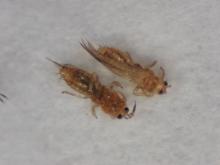Includes
Pear thrips (Taeniothrips inconsequens)
Western flower thrips (Frankliniella occidentalis)
Pest description and crop damage Adult thrips are small (about 0.04 inch in length at maturity), slender insects with fringed wings. They are generally white when young but brown or black when mature. Larvae are very tiny and difficult to distinguish without magnification. In apples, thrips feed on developing fruits which causes a white "pansy spot" to develop.
Biology and life history The western flower thrips has several generations and is a widespread problem on tree fruits and other crops in the PNW. Damage to apples occurs during bloom, when female thrips lay eggs into developing fruit. A pale area, known as "pansy spot," develops around the scar where eggs were deposited, and is especially noticeable on light-skin apple cultivars. If only one spray is applied, pink and petal fall timings give equivalent control.
The pear thrips has only one generation and destroys the fruit buds and flowers of fruit trees during bloom. This pest has become a localized problem in the mid-Columbia fruit-growing area, especially in orchards that border habitat with native hosts such as maple and other deciduous trees. Use a beating tray during the pink stage to monitor and detect immigrating pear thrips along border rows of the orchard. Pear thrips is best controlled at the early pink stage.
Management-cultural control
Manage weedy vegetation within and around the orchard (especially blackberry, mustard and radish). Do not mow cover crops or weeds, since mowing may cause thrips to disperse to the fruit trees.
Management-chemical control: HOME USE
Stages 5-6: Pink spray
- acetamiprid
- azadirachtin (neem oil)-Some formulations are OMRI-listed for organic use.
- carbaryl-Highly toxic to bees.
- gamma-cyhalothrin-Highly toxic to bees.
- insecticidal soap-Some formulations OMRI-listed for organic use.
- kaolin-Applied as a spray, it acts as a repellant to target pests. Some formulations are OMRI-listed for organic use.
- malathion-Highly toxic to bees.
- permethrin-Highly toxic to bees.
- plant-derived essential oils-Some have shown efficacy against thrips. Some formulations are OMRI-listed for organic use.
- pyrethrins (often as a mix with other ingredients)-Highly toxic to bees. Some formulations are OMRI-listed for organic use.
- spinosad-Highly toxic to bees. Some formulations are OMRI-listed for organic use.
- zeta-cypermethrin-Highly toxic to bees.
Management-chemical control: COMMERCIAL USE
Stages 5-6: Pink spray
- Chromobacterium subtsugae (Grandevo) at 2 to 3 lb/A. Under heavy pest populations, apply a knockdown insecticide prior to use or in a tank mix, use the higher label rates, shorten the spray interval, and/or increase the spray volume to improve coverage. REI 4 hr. OMRI-listed for organic use.
- spinetoram (Delegate WG) at 4.5 to 7 oz/A in up to 100 gal water per application. Do not exceed four applications per growing season. REI 4 hr. [Group 5]
- spinosad (Entrust 80WP) at 2 to 3 oz /A in up to 100 gal water per application. Do not exceed 9 oz /A per season. REI 4 hr. [Group 5] OMRI-listed for organic use.
- tolfenpyrad (Bexar) at 21 to 27 oz/A in up to 100 gal water per application. See supplemental label. Aerial applications not allowed. No more than two applications. REI 12 hr. PHI 14 days. [Group 21A]



